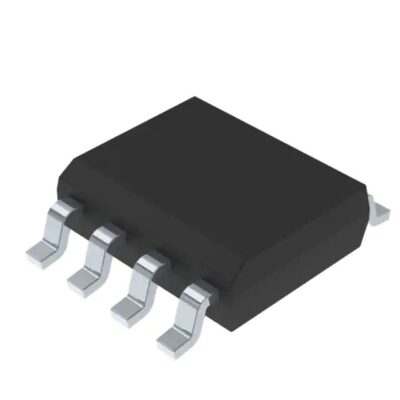L6562DTR
Part Number: L6562DTR
Manufacturer: STMicroelectronics
Description: IC PFC CTRLR TRANSITION 1MHZ 8SO
Shipped from: Shenzhen/HK Warehouse
Stock Available: Check with us
ICRFQ.com - Electronic Components Distributor in China Since 2003

Part Number: L6562DTR
Manufacturer: STMicroelectronics
Description: IC PFC CTRLR TRANSITION 1MHZ 8SO
Shipped from: Shenzhen/HK Warehouse
Stock Available: Check with us
| Datasheet | |
|---|---|
| Category | Integrated Circuits (ICs) |
| Family | PMIC – PFC (Power Factor Correction) |
| Manufacturer | STMicroelectronics |
| Series | – |
| Packaging | Tape & Reel (TR) |
| Part Status | Active |
| Mode | Discontinuous (Transition) |
| Frequency – Switching | 1MHz |
| Current – Startup | 40μA |
| Voltage – Supply | 10.3 V ~ 22 V |
| Operating Temperature | -25°C ~ 125°C |
| Mounting Type | Surface Mount |
| Package / Case | 8-SOIC (0.154″, 3.90mm Width) |
| Supplier Device Package | 8-SO |
In the realm of power factor correction (PFC) applications, one component stands out for its exceptional performance and efficiency – the L6562DTR. This specialized PFC controller is the key to unlocking optimal power factor correction, improving power efficiency, and reducing energy wastage.
Power factor correction plays a crucial role in modern power systems by ensuring that electrical loads draw power from the grid efficiently, minimizing energy losses and reducing the burden on the power infrastructure. Within this landscape, the L6562DTR shines as a reliable and versatile PFC controller that enables efficient and reliable power factor correction.
A specific PFC controller that is essential to power factor correction is the L6562DTR. It is made to control power supply input current, ensuring a power factor that is close to unity. The L6562DTR facilitates effective power transmission from the grid to the load by precisely regulating the input current waveform.
The L6562DTR’s unique features and capabilities make it a powerful tool for optimizing power factor correction. Its ability to accurately shape the input current waveform, coupled with programmable functions and robust protection mechanisms, enables enhanced power efficiency and reliable operation in various applications.
The L6562DTR boasts several key features that contribute to its effectiveness in power factor correction:
The L6562DTR supports a large input voltage range, commonly ranging from 85V to 265V AC. Maximum operating frequency: The L6562DTR supports a wide operating frequency range. Compatibility with many power supply applications is made possible by this wide range. The L6562DTR also has a high frequency range, with typical maximum frequencies of up to several hundred kilohertz.
The L6562DTR uses a current sensing amplifier, a high-performance device that precisely monitors the input current for power factor adjustment. It also has programmable functions. As a result, the input current waveform may be precisely controlled and shaped, improving power factor and lowering harmonic distortion. The slope compensation feature of the L6562DTR allows for fine-tuning the control loop and optimization for various operating conditions and load needs.
The L6562DTR is offered in a small, industry-standard SO-8 (Small Outline-8) packaging, which offers a variety of pin configuration options. This package type makes PCB designing simple and is compatible with preexisting designs. Essential pins like VCC, VFB, COMP, CS, and OUT are included in the pin arrangement, making it simple to integrate and connect in power supply circuits.
The L6562DTR’s major characteristics and specifications, such as its integrated PFC controller, protection mechanisms, wide input voltage range, current sense amplifier, programmable functions, and packaging possibilities, make it a flexible and effective solution for power factor correction applications.
Several electronic devices, including power supply, lighting systems, and industrial machinery, make use of the L6562DTR.
The L6562DTR improves power factor correction, increasing efficiency and lowering energy waste in power supplies.
Lighting Systems: It makes sure that there is consistent illumination, good power efficiency, and less flickering.
Industrial Equipment: By enabling effective power factor adjustment, the L6562DTR improves system effectiveness and complies with power quality regulations.
Renewable Energy Systems: It optimizes power factor correction in renewable energy systems, improving energy conversion efficiency and grid compatibility. C. Specific Examples and Use Cases:
The L6562DTR’s versatility is demonstrated in various applications, delivering benefits such as improved efficiency, stable performance, and compliance with industry standards.
In conclusion, the L6562DTR is a versatile and powerful solution for power factor correction applications. Throughout this guide, we explored its role in enhancing power efficiency, reducing energy wastage, and improving power quality. The L6562DTR’s built-in PFC controller, wide input voltage range, protection mechanisms, and programmable functions make it a valuable tool for electronic enthusiasts.
So, don’t hesitate to explore and experiment with the L6562DTR. Contact us at ICRFQ for sourcing and further assistance and Unleash its potential, harness power factor correction, and make a positive impact on power efficiency and quality. The L6562DTR awaits your innovative projects and offers a path towards more efficient and sustainable power systems.
WhatsApp us